Last year, around mid-summer, I built a small market garden near the center of Taos:
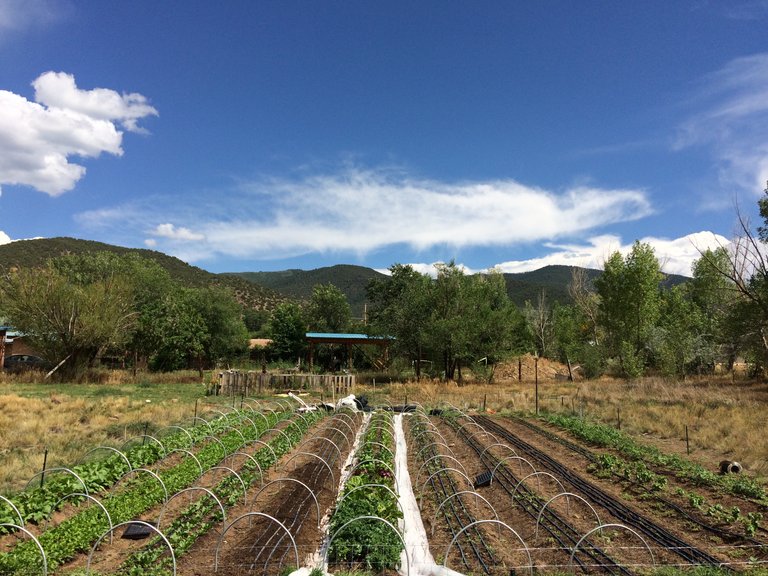
I grew an abundance of vegetables, such as Kale, Arugula, Swiss Chard, Spinach, Romaine, Lettuce Mix, Beets, Snow Peas, and Radishes. I sold them all to a local health food store and all was well in this beautiful little garden. It was only a mere 500ft of raised beds. Very small for a market garden! I was testing the waters, so to speak.
Building it was straight forward. I tilled out the perennial grasses and created raised beds. Then mixed in organic certified cotton burr compost. This is an excellent soil additive and conditioner. It's a mix of composted cotton plant leftovers certified for organic production. It is used as both a mulch and a soil builder. It doesn't say so on the package but it is LOADED with mycorrhizal fungi. You can tell because of the white, powdery, spiderweb looking stuff on the cotton stems and throughout the mix.
Then I inoculated the garden with aerobic worm castings tea. Lots of healthy fungi and microbes!
After the mycorrhizal fungi and the worm casting bacteria and fungi reproduced and began to work their magic, the whole thing started popping off like crazy! The soil structure became "spongey" in a good way, and the water inputs just kept getting lower and lower. The yields were great and the plants were healthy.
This was a great garden, but to pay the bills I took on a job managing the farm at Red Willow Farm on the Taos Pueblo. That was an amazing job and I made some great friends. Sometime I would like to write about how inspiring that job was to me and what I learned while I was there.
Eventually I got too busy with my new job to continue to harvest from this garden. I stopped irrigating and left it to it's own devices. That was in September of last year (2017).
I would stop by this garden occasionally just to see what was up. I watched some plants survive for a VERY long time with no water inputs and it was quite encouraging. Mycorrhizal fungi do a neat trick where they lock moisture in the root zone through a symbiotic relationship with the plants. Very cool. Other microbes and fungi hold moisture by nature, since they are essentially little moisture holding life forms. Many of them also share symbiotic relationships in the root zone.
So, let's fast forward one year: I roll over there a couple of days ago to pull the shade hoops to move them to my new farm, and I am BLOWN AWAY by the effects the worm tea, mycorrhizal fungi and cotton burr have had on the plant life. Take a look for yourself!
This is a picture of how the spot looked when I broke ground last year:
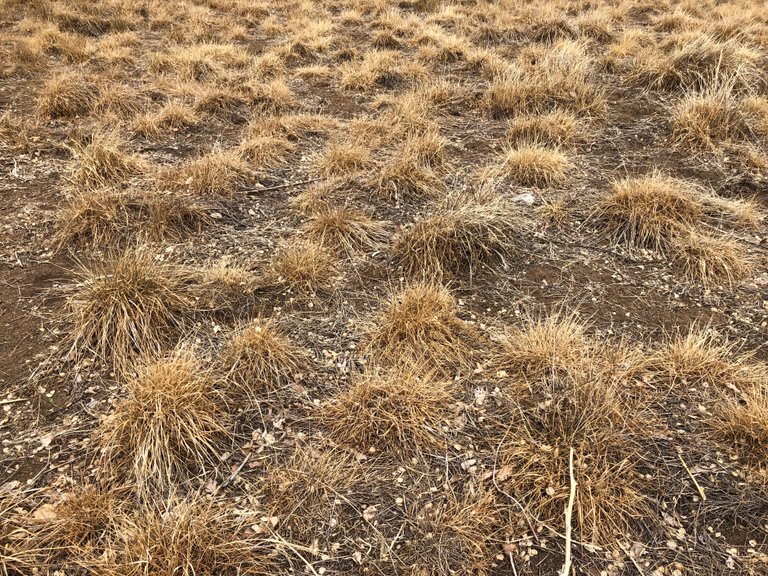
And below is a picture of it now. It has received exactly the same amount of water as the surrounding grasses since I unhooked the irrigation about NINE months ago! This is awesome, because it's a real tangible accomplishment which I can now work towards replicating on a larger scale. Next stop, my new farm, and then next stop, hundreds of acres of land restored! I like to dream big....
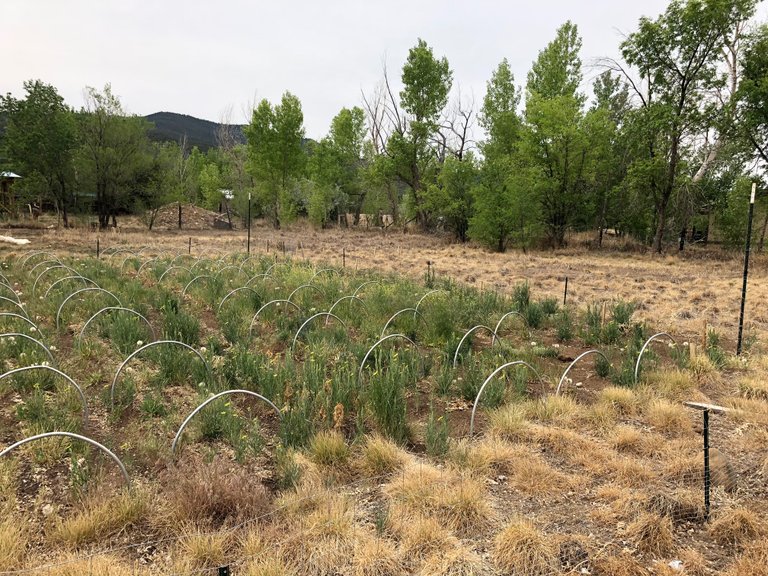
This ladybug is stoked to have some Milkweed to hang out and lay eggs and eat aphids on. That's gonna make for some happy birds. The beautiful spiky yellow flower on the Milkweed is going to catch the eyes of some pollinator insects. Many things going on here that weren't last year.
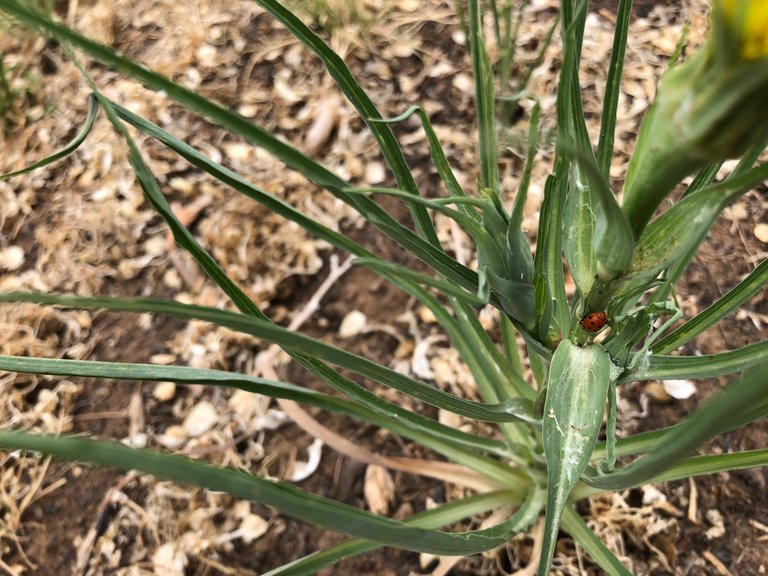
This Red Russian Kale plant is flourishing with NO water inputs except the natural rainfall, which trust me, has been very sparse. We've had rain maybe once or twice in the past several months unfortunately. I am going to save the seeds off of this plant and have some VERY drought tolerant kale for a reliable food source in coming years.
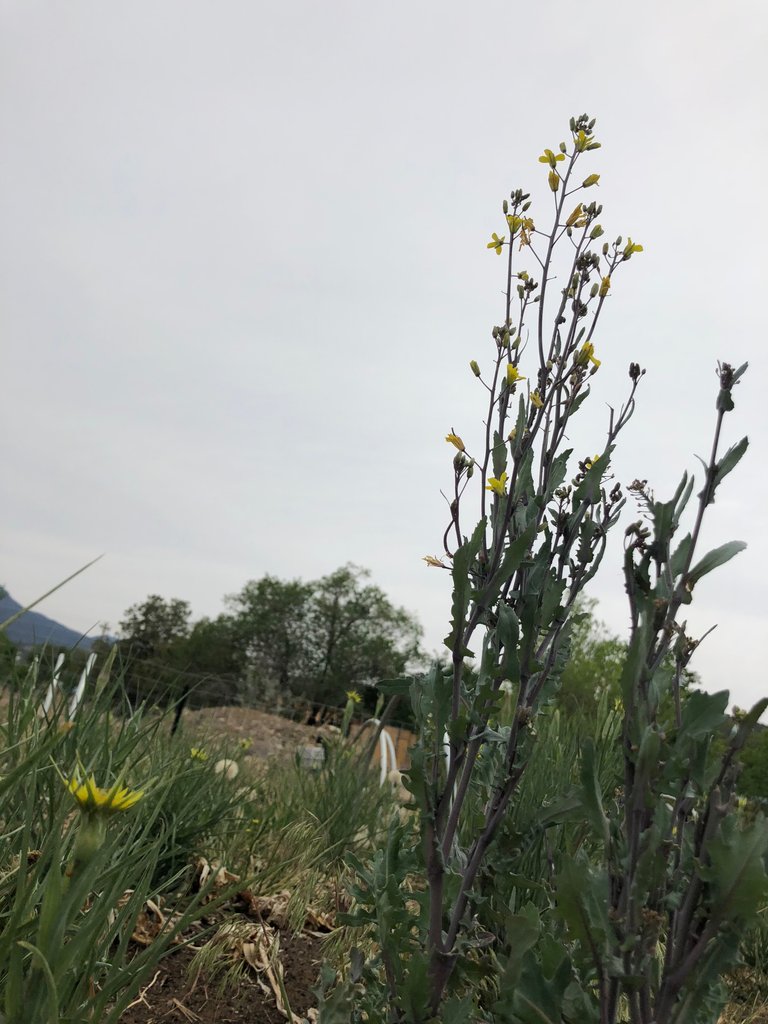
This Arugula plant is also thriving. This plant is also called "Spanish Cross" around here because of it's beautiful little white flowers which are cross shaped.

Folks, we can rebuild our food systems and our environment from the ground up. Nature has a way of taking care of itself, and once the essential elements are in place, things can flourish and grow on their own, even dry and harsh climates like up here in the high desert. I want to learn as much as I can about how I can continue to make this happen. I dream of pulling this off on a large scale! Please stay with me on this journey, and if you like this post, upvote, resteem, or comment below! Thanks for reading!
Very cool outcome! Nice work. I found you on the #payitforward contest. You were featured by @buckaroo. Congratulations.
Thanks! I appreciate it
Wow! That really is amazing!! Nature really does know how to handle herself, if only we humans would quit trying to interfere :)
So true and mind-blowing when you think of it!!
I found your post because @thelaundrylady featured you in thedarkhorse's pay it forward contest :)
Thank you for visiting my nominees. Really appreciate what you guys are doing! Upvoted your comment with 100% power from me.
Thank you @thelaundrylady! You were my choice for the week too :)
I saw! Thank you so much!
I know it's crazy .. just put the elements together and let things take care of themselves!
I wonder when everyone will realize that they should stop trying to control nature and just her take care of herself. She's been doing it for a while I think ;)
Where I live is a sand oasis. We quickly discovered vermicomposting and have embraced it's miraculous transformation. I look forward to finding some of that cotton burr compost you referred to. Can't wait to see what you do at the next place!!!
This is so inspiring Nick. I do need to start a worm farm!
Is that what that stuff is!!!! Amazing...!!!
Yeah start one they are not hard to get going!
This is an awesome post! You and I have a lot alike gardening wise. I also use organic certified cotton burr compost, mycorrhizal fungi & worm casting. It's really cool to read someone else having the same experience with the things I am using. It's great you wrote so much about mycorrhizal fungi! We can't see them yet they are so important. Do you see more of a benefit in using worm tea than just using worm casting? I am too lazy to brew worm tea, so I have not use the casting that way yet.
I love the Arugula flowers. They are so unique. I would grow them just for the flowers. It's a good idea to save the seed of that Red Russian kale. You might have something there. You have a market garden. How cool is that! Can't believe I am just seeing your post for the first time. I am following you now!
Nice! That is really cool. I definitely do see a difference with the tea. So my understanding is this: There is a microbial colony of about 100 different bacteria and fungi in the castings. You can take about 1 pound of the castings, and mix it with 55 gallons of warmish water, then keep it aerated and wait about 6 hours. The microbes will all reproduce and then peak population. You can also add alfalfa meal or sugar or something like that if you want to aid in that process. That will help the bacteria reproduce, not totally sure about the fungi. It's complicated science and I'm not a scientist! Anyway. Spray your soil with this mix, and then keep the soil moist like you would for a seed bed for a couple days. These bacteria and fungi will continue to reproduce, until they create a healthy, highly diversified colony throughout your soil. 55 gallons will do a pretty large area. Maybe about a quarter acre. Also the soil needs to be moist to start so the microbes stay in place. They will form symbiotic relationships in the root zone and even into the foliage, and they also create a highly competitive environment that makes it harder for pathogenic fungi and bacteria to take hold. I find it so amazing how all this works. You don't need many castings because they are essentially just a host for your original microbial colony. I would recommend the book "Teeming with Microbes" and also looking up lectures by David C. Johnson, Ph. D. and the Johnson Su Bioreactor on youtube to learn more about this process. Thanks for the in-depth response! I'm glad we found each other on here....
This is great info. I brew cotton burr compost tea sometimes, so sounds like worm tea has the same procedure. I do add black strap molasses to the tea while it is being aerated. I love reading about microbes. Have not heard of the book or the names you mentioned. I will look them up. Thanks!
Wicked @nickhans! you might enjoy, Geoff Lawton and his greening the desert project? Amazing results with the microrizal fungi.
That's the second time I've heard of him here
Now I'm.going to look that up!
Geoff Lawton is awesome great recommendation, he is really good at releasing his teachings free for download on the internet x
It was you who mentioned him.. That's right!!! I will dive into it ... thanks!!!
Nice... I'll check it out! Thanks
Wow that guy is a master... I watched the one about the land by the dead sea... I am still just learning and a beginner. So much inspiration. Thanks!
Ikr! I am going through his PDC free lectures right now and can't get enough. The work he's doing in Jordan is proving you can re-green the deserts! So much inspiration for the future. Its all in our hands to learn and implement.
really loving all these inspiring posts @nickhans, this information is so important and now it's on the blockchain forever,nice job x
Thanks so much. I am stoked to have a platform where I feel like folks are supportive of what I'm about... Really happy to be a part of Steem and the Tribesteemup community in particular
nice one @nicckhans, that's what it is all about. Looking forward to learning more from you x
Hello again @nickhans visiting again since @thelaundrylady featured you for this week's Pay It Forward Curation Contest.
Another awesome post, I am big believer in permaculture and in Taos, I can bet that was no easy task. I may pick your brain since I live in a similar climate have had some struggles. Keep up the great work you're doing!!
Thanks! I am just learning the basics of permaculture. I am a vegetable grower primarily... I have just been super inspired to move forwards with permaculture ideas. This is an excellent region to do that kind of thing, because as soon as you control and hold moisture in place, and then add organic matter back, you can see major transformations. This is a desert - but also very green, things like oak trees and willow trees grow here, for example. So once land is remediated, it seems that it will stay that way with very little input. So, there is a huge amount of potential for permaculture here. Thanks for reading! I appreciate it
For now, I just want to get to the point where we grow our own vegetables and find an adequate watering system. I was looking into a keyhole garden. I had been using raised beds but with the wind and the heat in the summer things dry out quickly.
I am really struggling with that this year. It's hot, windy and dry.. more than normal.. barely any rain for months. That other garden looks beautiful now, but during the time it was getting established, the weather was more cooperative. My new spot I am at now is having issues establishing because of the drought and harsh conditions. We were getting over 50 degree swings in temperature every day for a while, for example. It's really an exercise in perseverance but I am moving forward everyday. Row cover and mulch has helped some. Anyways, best of luck....
Most welcome to sir
This is awesome. I have never heard of cotton burr compost! This is the kind of thing I'd like to do: help and remediate things human impact has damaged. Thank you for sharing this with us!
No problem! Cotton burr compost is good stuff, but make sure to get the "Back to Earth" brand or ask a lot of questions about the source. If it's not organic, don't touch it cause conventional cotton fields are loaded with pesticides. Thanks for the comment :)
This is great for people to see. We run a small worm farm business and brew different types of worm teas. Your bacterial teas are better for growth in a garden with good soil but for starting out improving soil in sandy conditions fungal teas will do what you want. Nice article.
Nice! How can you brew a tea to have more fungi? I am pretty new to all this. I had heard the ratio of aerated castings tea was usually 1:1 unless you add something like sugar or alfalfa meal to up the bacteria. And I have also read that there is a lack of mycorrhizal fungi in the tea, so they need to be added separately. I would love to have a microscope and figure things out more from there. By the way, your blog posts are really informative. I am following you and wish you the best! Thanks for the response
You can do things like grab a few handfuls of soil from a wooded area around you that will up fungal counts for the most part. Any type of high carbon based compost or worm castings will have a higher count of fungi in it so compost or worm bins made with lots of dried leaves etc would produce a good fungal counts if the other conditions are right. Bacterial microbes will feed on a food source like molasses or a sugar based feedstock where as when I want a higher fungal count I use things like yucca or seaweed extract. Fungi do better with more carbohydrates (cellulose) or simple proteins. I do different brews for different things. Potted or raised beds with quality soil I do bacterial since the plants will usually get more out of it but in sandy soil or more long term for pasture improvement I use fungal teas. I add several meals and soil amendments along with castings, frass and a feedstock for the brews and sometimes I do basic castings and feedstock.
Great that answers my question, thanks.
What an incredible post! I think you've done something really incredible. Nice work!
Thank you!! I am just a beginner, learning every day. I appreciate it.